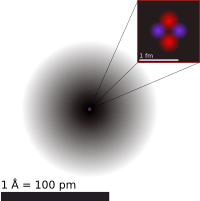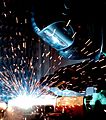Particle facts for kids

Particles are tiny bits of matter that make up everything in the universe. In particle physics, an elementary particle is a particle which cannot be split up into smaller pieces.
There are many different types of particles, with different particle sizes and properties.
Macroscopic particles are particles that are larger than atoms or molecules. They have volume and shape. Powder and dust are some examples of macroscopic particles. Nanoparticles are an intermediate size, being a very fine powder but very much bigger than atoms.
Atoms and molecules are called microscopic particles. Subatomic particles are particles that are smaller than atoms. The proton, the neutron, and the electron are subatomic particles. These are the particles which make atoms. The proton has a positive charge (a + charge). The neutron has a neutral charge. The electron has a negative charge (a - charge), and it is the smallest of these three particles. In atoms, there is a small nucleus in the center, which is where the protons and neutrons are, and electrons orbit the nucleus.
Protons and neutrons are made up of quarks. Quarks are subatomic particles, but they are also elementary particles because we do not know if they are made up of even smaller particles. There are six different types of quarks. These are the up quark, the down quark, the strange quark, the charm quark, the bottom quark, and the top quark. A neutron is made of two down quarks and one up quark. The proton is made up of two up quarks and one down quark.
Quick facts about particles
- Everything in the world is made up of particles.
- There are different types of particles, depending on the size and properties.
- Macroscopic particles are particles large enough to be seen with the naked eye - like powder and dust.
- Atoms and molecules are microscopic particles. They are so tiny that we can not see them unless unless we use very powerful microscopes. Molecules are made up of atoms.
- Atoms are made up of subatomic particles - protons, neutrons, and electrons.
- Protons and neutrons are made up of quarks. Scientists don't know yet if quarks are made up of even smaller particles.
- Depending on how much space is present between particles, things can be solid (less space), liquid (more space), or gas (even more space). Because there's so much space between particles in liquids and gases other objects can easily move through them. As temperature and pressure change things can go from gases into liquids and solids. A good example of such transformation is water - it can be a gas (vapor in the air), a liquid, and a solid (ice).
Images for kids
-
Arc welders need to protect themselves from welding sparks, which are heated metal particles that fly off the welding surface.
See also
 In Spanish: Partícula (física) para niños
In Spanish: Partícula (física) para niños




